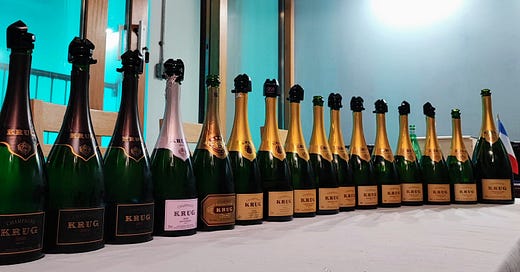Most of my actual wine reviews appear in Decanter magazine and Decanter Premium. This Substack is mostly for other things - I don’t rate or score wines here, and I don’t tend to writing tasting notes. However, having submitted a review of the excellent 172ème edition of Krug Grande Cuvée recently based on a few tastings, I found myself with rather a long list of back vintages tasted alongside Nick Baker of The Finest Bubble, Krug collectors and Olivier Krug himself, back in July. So, here are some actual words on actual wines!
A Grande Cuvée primer:
Grande Cuvée is Krug’s main production. Each vintage, a new ‘edition’ is blended which is then released approximately eight years later. Retail price in the UK is around £200. Don’t call it ‘non-vintage’, or ‘multi-vintage’, or ‘entry level’ when a bottle, or member of the Krug family, is listening, though - with, I have to admit, good reason, Krug resists being pigeon-holed.
So what is inside?
There is a ‘youngest’ wine in the blend - don’t call it a ‘base year’ (!) - which is always at least seven years old, but often more.
This is complemented by a large chunk of reserve wines, often running around 40% but varying depending on the year. Krug’s reserves are exceptional, and their harmony with the
base yearyoungest wine is the point of the blending process here. They’re kept very separated; there’s no perpetual reserve, or big reserve blends, here. They’re the story of Grande Cuvée, for me at least.All the wines are fermented, parcel by parcel, in old oak. But they don’t spend long there - after a brief dose of ‘inoculation’ against oxygen via the barrels they’re moved into steel after around 3 months. This is why Krug doesn’t tend to have an ‘oak’ signature….and also why the wine can strike a lovely balance between openness and reductive brightness.
The blend tends to be lightly Pinot Noir heavy, but it also includes a small amount of Meunier, often about 10%. (I’ve come across some great Meunier growers who sell to Krug, such as Yann Alexandre in Courmas). Krug have around 20 hectares of their own vineyards, and source around 60-70% of supply via long term contracts.
For some Krug fans, Krug only really gets Krug-y after 10 years on cork or so…
When I’ve poured Grande Cuvée for people that haven’t tasted it before, it does tend to pass the Prestige test - i.e. even casual champagne drinkers tend to emit a few ‘ooh’ and ‘ahhs’. It’s reputation for being a big, hearty champagne is a little misplaced in my book; these days it tends to show its steely, smoky side in youth. Young Grande Cuvée blind can often be more linear than people expect.
The vintage bottling, and Krug Rosé, can be superb too, although Krug’s assertion that these (pricier) wines are not designed to be ‘better’ than Grande Cuvée rings true - if you’re drinking Grande Cuvée there’s no need to suffer FOMO (although the new Rosé 28ème edition, reviewed also at Decanter, is delicious and we had two superb vintage releases, listed below).
I don’t do scores here, but since I do have them I’ve presented the below with a loose ranking, starting with some of my favourite wines of the tasting (which can’t really be separated on quality).
Keep reading with a 7-day free trial
Subscribe to Six Atmospheres | Champagne & Sparkling Wine to keep reading this post and get 7 days of free access to the full post archives.





